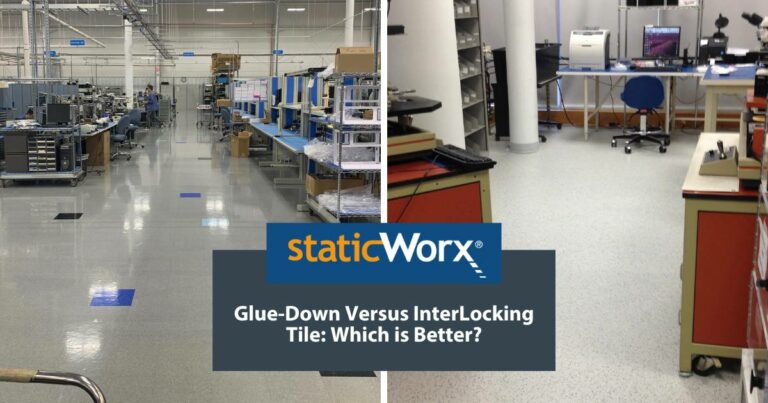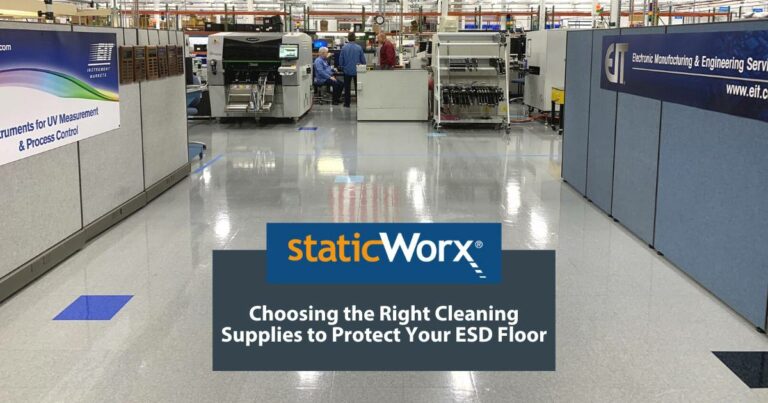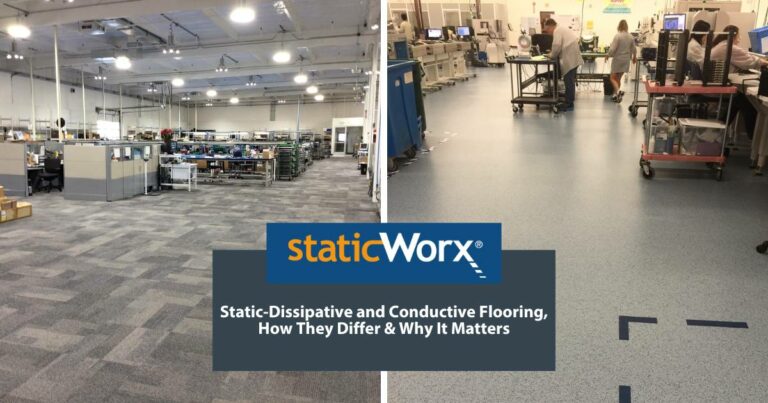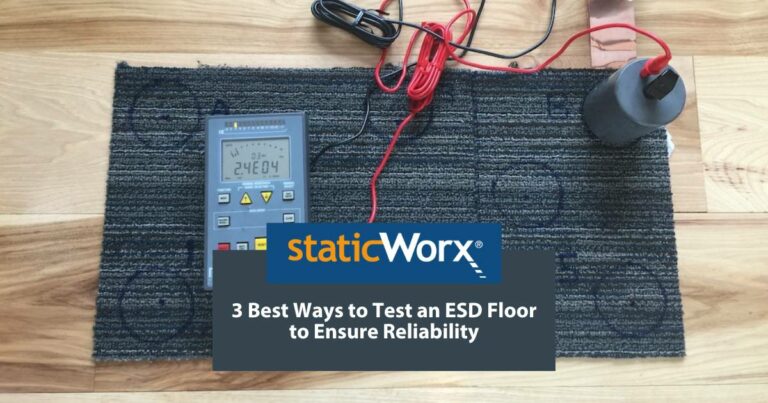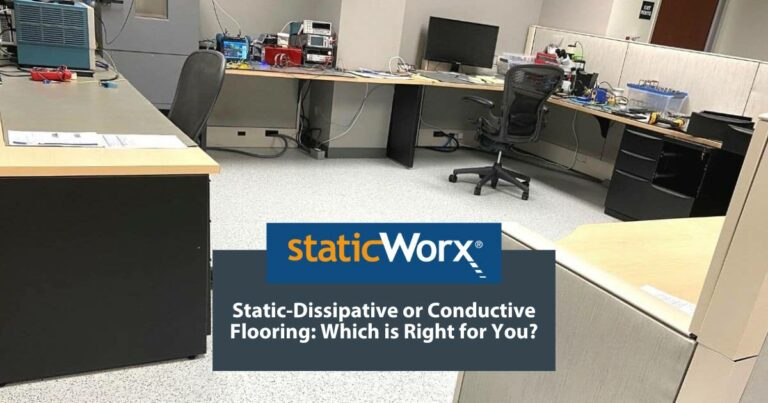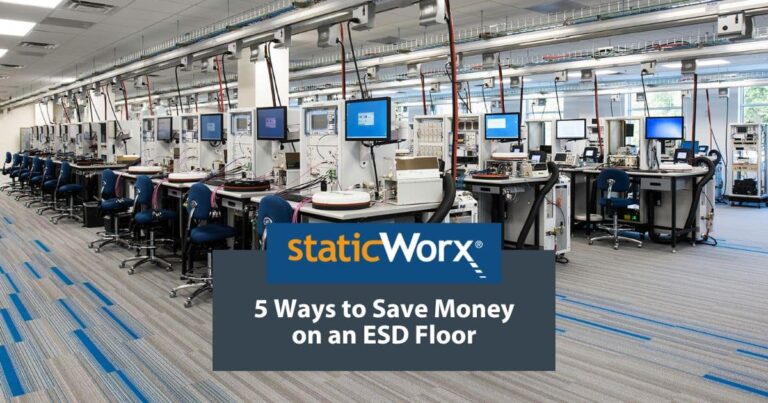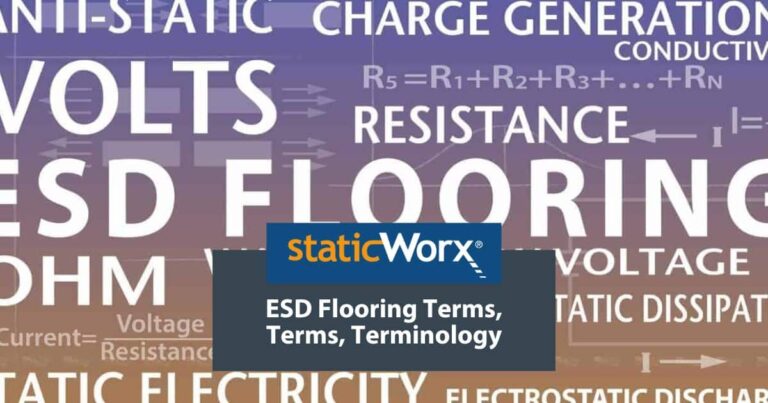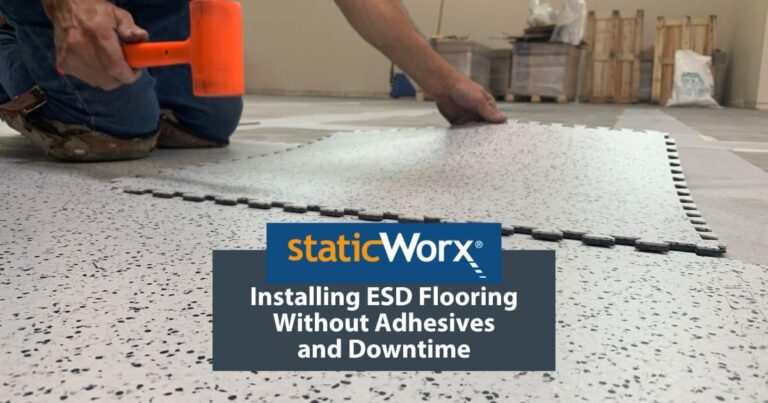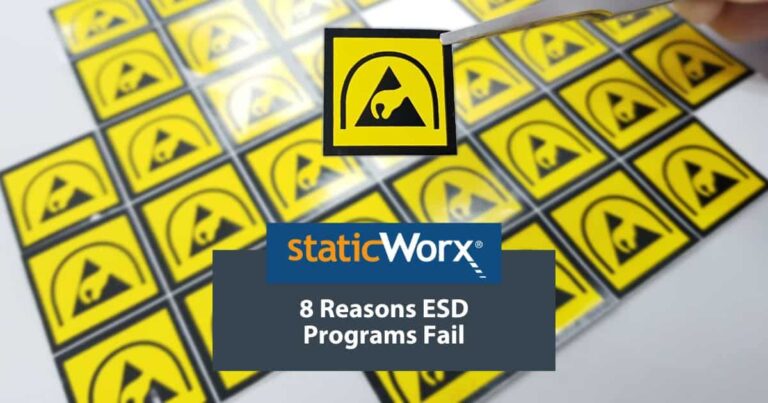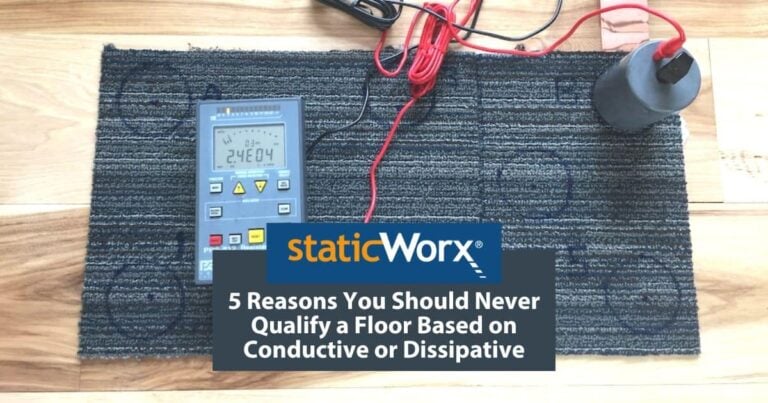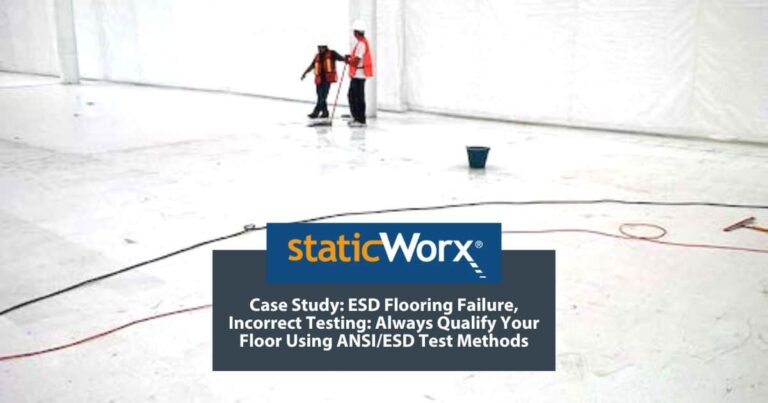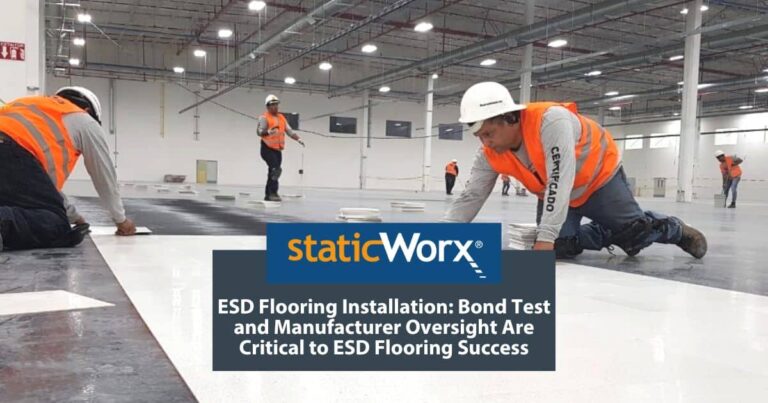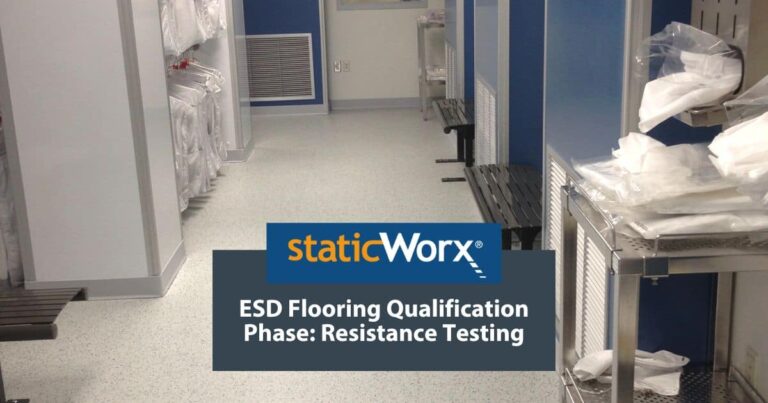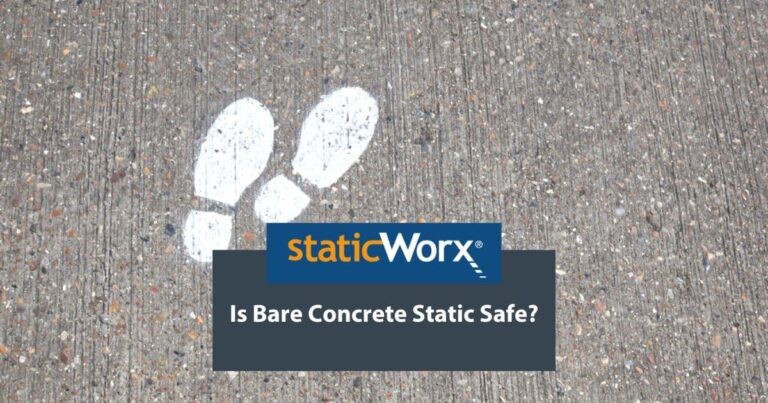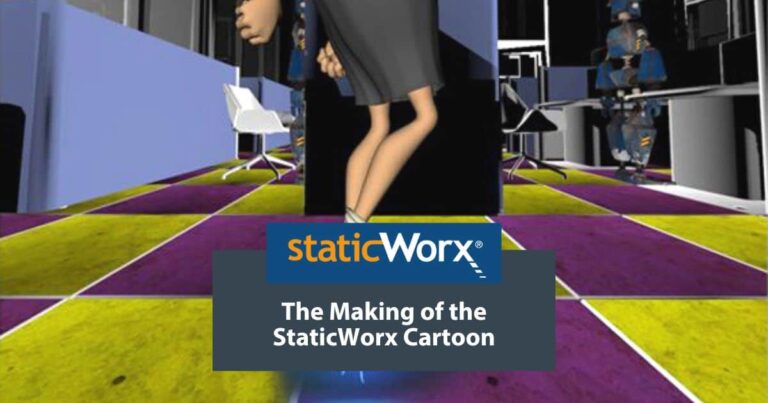Learn the differences between ESD solid vinyl tile and interlocking ESD tile. The post compares specs, installation, maintenance and intangibles.

Static Dissipative Flooring - What It Is & Why You Need It
7 min read
Static-dissipative flooring is a type of specialized flooring designed to minimize the buildup of static electricity and dissipate static charges to ground. This type of flooring is commonly used in environments where random electrostatic discharge (ESD) events pose a risk to sensitive electronic equipment, flammable materials, or human safety.
Static electricity is an invisible phenomenon that occurs when two objects with different electrical charges come into contact then separate. The resulting friction causes electrons and protons to move from one object to the other, causing a buildup of electrical potential or static charge. When a charged person or object touches another person or object, charges jump from one to the other in the form of an electrical spark.
In industries such as electronics manufacturing, aerospace, pharmaceuticals, chemical processing, or end-user facilities such as PSAPs, banking, communications to name just a few, static electricity can be disruptive, damaging and in some cases even dangerous
Static-Dissipative Flooring Provides a Conductive Pathway to Ground
Static-dissipative flooring is a flooring material that dissipates static charges – in other words, has the ability to transport or conduct electrical charges to ground. Dissipative flooring works by providing a conductive pathway for potentially harmful static charges, enabling these charges to flow safely and at a controlled pace to ground.
Static-dissipative flooring consists of a combination of materials with low electrical resistance, such as carbon fibers, copper wires, or metallic particles, and a top layer of carpet, vinyl, epoxy, or rubber. The conductive elements, embedded within the flooring material during the manufacturing process, ensure consistent conductivity throughout the thickness of the floor.
“Static-dissipative” is also a technical term for a category of flooring that conducts static charges. To be categorized as static-dissipative, the floor must test equal to above 1 million ohms (>1.0 x 10E6 ohms) and below one billion ohms (<1.0 x10E9 ohms), measured using an ohm meter, following guidelines in ANSI/ESD STM7.1.
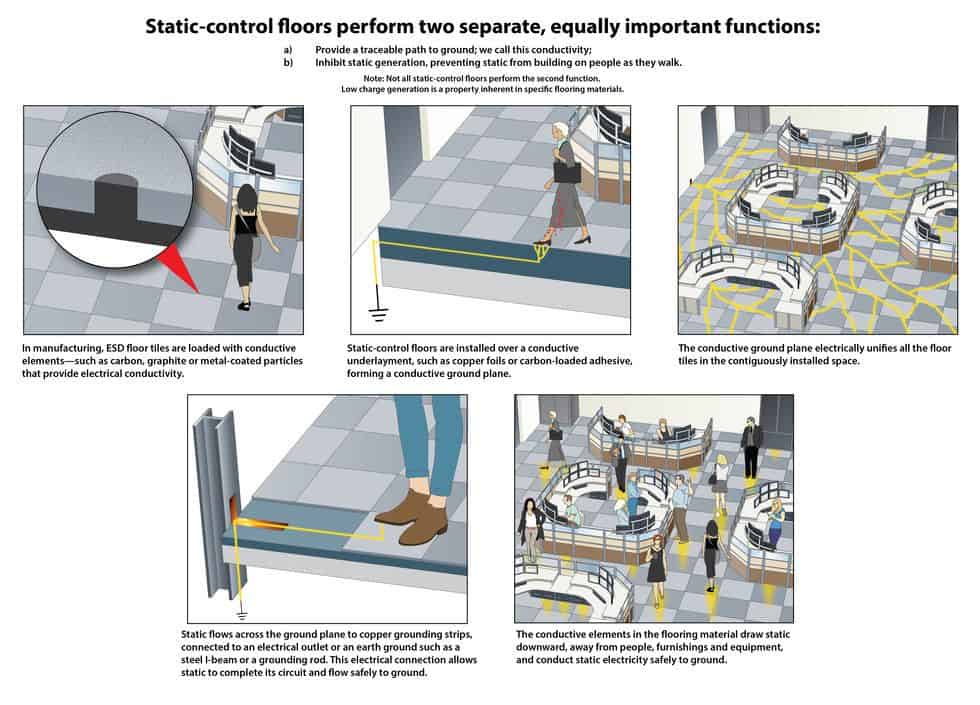
What Types of Flooring Can Be Static Dissipative?
There are four types of static-dissipative flooring, each with its own advantages and disadvantages, depending on the application and environment. These include:
1. Vinyl Flooring
This is the most common type of static-dissipative flooring, made of a combination of vinyl and carbon particles. Static-dissipative vinyl is durable, easy to clean, and affordable. However, it should not be used without special ESD footwear. Static-dissipative vinyl will not ground static charges unless all personnel walking in the facility wear static-control heel straps, toe straps, sole straps or ESD shoes. Without the use of static-control footwear, dissipative vinyl, while better than standard vinyl, is not as effective as other ESD options.
2. Carpet Tile
Static-dissipative carpet tile is an aesthetically pleasing, high-performing type of ESD flooring. Conductive fibers embedded in the yarn bundle wipe static from shoe soles and dissipate charges to ground. Carpet tile is less expensive than some ESD flooring options. Easy to install without adhesive, it can be installed 24/7 with no downtime. Carpet is also easy to maintain and repair. Carpet is not a good solution for facilities that work with harsh chemicals that may be spilled or that drive heavy equipment such as fork lifts or pallet jacks over the floor. Carpet is an excellent antistatic option: It inhibits static on personnel extremely well even if they are wearing ordinary footwear.
3. Epoxy Flooring
ESD epoxy is made of a combination of epoxy resin and conductive fillers, such as carbon flakes or conductive nano-particles. Static-dissipative epoxy is extremely durable and chemical-resistant, and can withstand heavy loads such as forklifts and pallet jacks. While the material cost may be low, epoxy is time-consuming to install and usually requires professional installation. Epoxy also scratches, is difficult to repair, and looks best the day it is installed. Like ESD vinyl, static-dissipative epoxy does not work well without the use of ESD footwear.
4. EC (electrically conductive) Rubber Flooring
This type of flooring has carbon particles embedded in the rubber. EC rubber flooring is often used in areas that generate high static charges, such as cleanrooms, control rooms, data centers or laboratories. Rubber is resistant to chemicals, abrasion, and punctures, is easy to maintain and naturally antistatic. In fact, EC rubber is the only resilient flooring that effectively inhibits static without the use of special ESD footwear. The downside is that rubber is the most expensive static-dissipative flooring material.
Static-dissipative flooring is designed to meet specific industry standards for electrical resistance and charge generation, published by standards organizations such as ASTM F150, ANSI/ESD S20.20, and IEC 61340. The level of conductivity required for a particular application, as well as the acceptable voltage generation, depend on the application, sensitivity of the equipment, operational risks and type of work being done in the facility.
Some industries may require flooring with a resistance range of 1 million to 1 billion ohms, while others – facilities handling explosives, for example – require a floor in the conductive range of 25,000,000 to < 1 million ohms. Likewise voltage generation: in electronics facilities, static generation must be <100 V while end user spaces can generally withstand up to 500V.
Static dissipative flooring is essential in industries that rely on sensitive electronic equipment or that handle hazardous materials. By providing a safe and reliable way to manage static electricity, static-dissipative flooring helps prevent damage to equipment and reduces the risk of fire or explosion, helping create a safer working environment for employees. ESD standards are different in different industries and vary by application. If you’re considering installing static-dissipative flooring in your facility, be sure to consult with a qualified flooring expert to determine the best type of flooring for your application, which standards to follow, and how to best meet your goals and objectives.
About StaticWorx, Inc
All StaticWorx posts are written by our technical team and based on industry standards and specifications, test data, independent lab reports and other verifiable data. We provide ESD training and offer CEU credits to architects. If you’re interested in an ESD training session or architects’ ESD workshop, give us a call: 617-923-2000.
Get in Touch
The form below will help us better understand your needs and get you as quickly as possible to the right person. We look forward to helping you solve your static problem!
You can expect a response within 24 hours. For faster service, please give us a call: 617-923-2000
"*" indicates required fields
Visit our privacy policy to find out how we process data.
More Blog Posts
To maintain performance, ESD floors require specially formulated products. We offer tips on what to consider when choosing cleaning supplies.
StaticWorx recognized as one of the fastest growing private companies in the U.S. 2023 marks StaticWorx fourth appearance on Inc. 5000 list.
Conductive and dissipative flooring protect electronics by transporting charges to ground, conductive at a quicker rate, dissipative slower & more controlled.
We explain the 3 main ways to test an ESD floor: Electrical resistance; body voltage & ESD audits, with advantages and reasons for each.
Three critical factors—application, industry standards & footwear—help you choose the best ESD floor, while ensuring the safety & efficiency of your operations.
StaticWorx Founder and President Dave Long shares three of his recommended reads: Quit, How to Change, and The Goal.
There are leadership qualities StaticWorx strives to embody every day, with every product, throughout each project.
No matter how you slice and dice a project, an ESD floor is a major investment. This blog post examines five ways to keep undue costs down.
What’s the difference between static control and static resistant? Or anti-static flooring? Find out more in our blog post.
A major part of any ESD control program is getting proper flooring in place. How can one replace a floor without generating any debris? Learn more.
A well-designed, comprehensive, fully realized program is a must for manufacturers serious about ESD control. Learn why ESD programs fail.
ESD Floors should never be specified based on the descriptive terms conductive or static dissipative. Always base ESD specs on verifiable metrics. Find out why.
To comply with relevant ESD standards, test electrical properties using methods outlined in ESD S20.20. For best results require testing by an independent lab.
If the vapor barrier fails to adhere to the subfloor, tiles will lift. Bond test and manufacturer oversight are crucial to ESD floor installation success.
Blog Post: Conductive and Static-Dissipative Flooring: What’s the Difference?
The Layperson’s Answer
What’s the difference between conductive and static-dissipative flooring? Facts, analogies and images illustrate the difference in easily understood terms.
Qualifying an ESD floor helps ensure you get the floor you paid for. Find out why you should always qualify according to ESD S20.20
Qualification is the first step in selecting an ESD floor. Learn how to perform resistance tests to be sure the floor meets electrical & safety standards.
Will bare concrete control static? Learn why concrete floors are unreliable & what precautions to take if you must work on a bare concrete floor.
A look at how the StaticWorx cartoon, 'Conductive Flooring Does Not Mean Antistatic Flooring,' was conceived and created.
Learning Center Articles
- ESD Basics
- Installation & Maintenance
- Selecting & Specifying an ESD Floor
- Technical Information
- 7 Common Mistakes Selecting an ESD floor
- A Guide to ESD Flooring Selection
- Avoid Costly Failures: What You Need to Know When Specifying ESD Flooring
- Choosing ESD Flooring for:
- ESD Footwear: What Is It and When Is It Necessary?
- ESD Footwear for Electronics Manufacturing and Handling Applications
- Facility Managers’ Guide to Selecting ESD Flooring
- The Need for Due Diligence in Specifying Static-Free Flooring
- Standard of Care for Specifying Floors in Mission-Critical Spaces
- Understanding the Hidden Costs of ESD Flooring

StaticWorx high-performance static-control floors protect electronic components, explosives, and high-speed computers from damage caused by static electricity. ESD flooring is part of a system. Choices should always be based on objective, researched evidence. When you partner with us, we look at all possible items that may need to integrate with the floor, and, focusing on your goals and objectives, help you find the right floor for your application.




